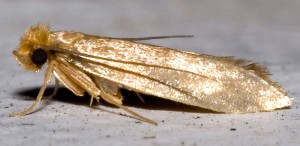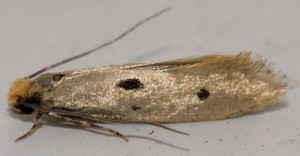When moths are found in clothing, they typically belong to one of two species:
These are the two species of moths that commonly attacks clothes. Occasionally, clothing can also be affected by brown house moth, and in very rare cases, by white-shouldered house moth. The presence of clothing moths is usually indicated by:
- Clothing with holes or small punctures
- Adult moths running around (clothing moths prefer to run rather than fly)
- Larvae, webs, or droppings on clothing or other textiles
- Pupal cases—whether containing larvae or not—found between walls and ceilings
If you suspect that you have seen larvae eggs, it is usually the droppings of the larvae.
Controlling Moths in Clothing
-
Inspection: Check all textiles in your home, paying special attention to stored or discarded items, particularly those that may be dirty. Moth larvae primarily consume organic textiles like wool, silk, fur, and leather, but they can also attack blended fabrics. Focus on the folds, pockets, and collars of clothing, as these are common areas where moths lay their eggs.
-
Cleaning: All infested textiles should be discarded or cleaned. Cleaning can be done through regular machine washing, dry cleaning, or freezing at -18°C. If washing in a machine, ensure the water temperature is at least 50°C to kill all moth eggs and larvae.
-
Cleaning: Empty all wardrobes and drawers, and thoroughly vacuum them. Pay special attention to clean edges, cracks, and crevices.
-
Storage: To prevent moths from laying eggs in your clothing in the future, store all clothing in airtight bags, especially items that are not used frequently. This also applies to infrequently used textiles in closets and drawers, such as guest towels, bed linens, and blankets.
-
Moth Bags: If you have previously experienced moth problems, there is a high likelihood they may return. Hanging moth bags in wardrobes and placing them in drawers can reduce the risk of moths reappearing. Moth bags are also the only chemical-free solution for clothing moths. You can read more about moth bags here.
We recommend using clothes moth traps and moth bags as they are both effective and environmentally friendly—note that one type of moth bag is designed for wardrobes while the other is for drawers.
Moths in Wool and Other Organic Materials
As mentioned, clothing moths primarily attack organic textiles—materials derived from animals. Wool is among the most vulnerable fabrics, but fur, silk, feathers, down, leather, and similar materials can also be targeted.
Blended fabrics, such as a down jacket with a thin synthetic outer layer, can be attacked by moth larvae that chew through the synthetic layer to reach the down inside. Similarly, a wool-cotton sweater can be damaged by larvae.
All textiles are especially at risk if they are slightly dirty and stored in undisturbed, dark places such as closets, drawers, chests, or basements.
Moths in Clothing and Food
Moths classified as pests are often divided into two categories:
- Clothing moths
- Food moths
Some moth species have larvae that thrive in food. These larvae primarily feed on dry goods like grains, flour, rice, cereals, and similar items.
Some species are nearly omnivorous and can also feed on dried plant materials, animal materials, wood fungi, and more. For example:
- Grain moths can feed on organic textiles (like clothes and fur moths), as well as plant and animal materials.
- Resin moths can consume the same materials as grain moths, but also more specialized materials like wood fungi, thatch, corks, and rotting wood.
In a typical UK home, it is often dry food items in kitchen cabinets—such as grains, bran, flour, cereals, rice, beans, spices, and dried fruits—that are targeted by moths.


